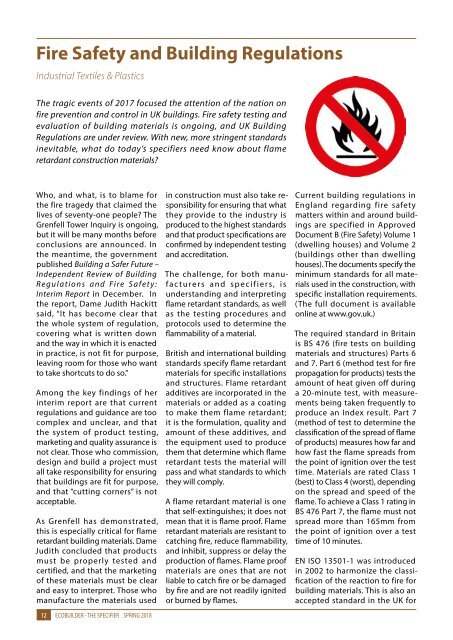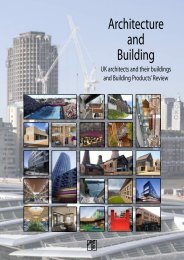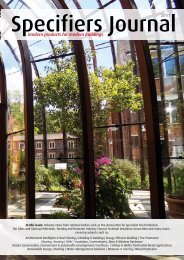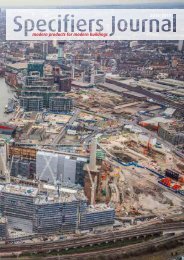ECOBuilder-Specifiers Journal spring2018
Create successful ePaper yourself
Turn your PDF publications into a flip-book with our unique Google optimized e-Paper software.
Fire Safety and Building Regulations<br />
Industrial Textiles & Plastics<br />
The tragic events of 2017 focused the attention of the nation on<br />
fire prevention and control in UK buildings. Fire safety testing and<br />
evaluation of building materials is ongoing, and UK Building<br />
Regulations are under review. With new, more stringent standards<br />
inevitable, what do today’s specifiers need know about flame<br />
retardant construction materials?<br />
Who, and what, is to blame for<br />
the fire tragedy that claimed the<br />
lives of seventy-one people? The<br />
Grenfell Tower Inquiry is ongoing,<br />
but it will be many months before<br />
conclusions are announced. In<br />
the meantime, the government<br />
published Building a Safer Future –<br />
Independent Review of Building<br />
Regulations and Fire Safety:<br />
Interim Report in December. In<br />
the report, Dame Judith Hackitt<br />
said, “It has become clear that<br />
the whole system of regulation,<br />
covering what is written down<br />
and the way in which it is enacted<br />
in practice, is not fit for purpose,<br />
leaving room for those who want<br />
to take shortcuts to do so.”<br />
Among the key findings of her<br />
interim report are that current<br />
regulations and guidance are too<br />
complex and unclear, and that<br />
the system of product testing,<br />
marketing and quality assurance is<br />
not clear. Those who commission,<br />
design and build a project must<br />
all take responsibility for ensuring<br />
that buildings are fit for purpose,<br />
and that “cutting corners” is not<br />
acceptable.<br />
As Grenfell has demonstrated,<br />
this is especially critical for flame<br />
retardant building materials. Dame<br />
Judith concluded that products<br />
must be properly tested and<br />
certified, and that the marketing<br />
of these materials must be clear<br />
and easy to interpret. Those who<br />
manufacture the materials used<br />
10 12 ECOBUILDER - THE SPECIFIER 2018 SPRING 2018<br />
in construction must also take responsibility<br />
for ensuring that what<br />
they provide to the industry is<br />
produced to the highest standards<br />
and that product specifications are<br />
confirmed by independent testing<br />
and accreditation.<br />
The challenge, for both manufacturers<br />
and specifiers, is<br />
understanding and interpreting<br />
flame retardant standards, as well<br />
as the testing procedures and<br />
protocols used to determine the<br />
flammability of a material.<br />
British and international building<br />
standards specify flame retardant<br />
materials for specific installations<br />
and structures. Flame retardant<br />
additives are incorporated in the<br />
materials or added as a coating<br />
to make them flame retardant;<br />
it is the formulation, quality and<br />
amount of these additives, and<br />
the equipment used to produce<br />
them that determine which flame<br />
retardant tests the material will<br />
pass and what standards to which<br />
they will comply.<br />
A flame retardant material is one<br />
that self-extinguishes; it does not<br />
mean that it is flame proof. Flame<br />
retardant materials are resistant to<br />
catching fire, reduce flammability,<br />
and inhibit, suppress or delay the<br />
production of flames. Flame proof<br />
materials are ones that are not<br />
liable to catch fire or be damaged<br />
by fire and are not readily ignited<br />
or burned by flames.<br />
Current building regulations in<br />
England regarding fire safety<br />
matters within and around buildings<br />
are specified in Approved<br />
Document B (Fire Safety) Volume 1<br />
(dwelling houses) and Volume 2<br />
(buildings other than dwelling<br />
houses). The documents specify the<br />
minimum standards for all materials<br />
used in the construction, with<br />
specific installation requirements.<br />
(The full document is available<br />
online at www.gov.uk.)<br />
The required standard in Britain<br />
is BS 476 (fire tests on building<br />
materials and structures) Parts 6<br />
and 7. Part 6 (method test for fire<br />
propagation for products) tests the<br />
amount of heat given off during<br />
a 20-minute test, with measurements<br />
being taken frequently to<br />
produce an Index result. Part 7<br />
(method of test to determine the<br />
classification of the spread of flame<br />
of products) measures how far and<br />
how fast the flame spreads from<br />
the point of ignition over the test<br />
time. Materials are rated Class 1<br />
(best) to Class 4 (worst), depending<br />
on the spread and speed of the<br />
flame. To achieve a Class 1 rating in<br />
BS 476 Part 7, the flame must not<br />
spread more than 165mm from<br />
the point of ignition over a test<br />
time of 10 minutes.<br />
EN ISO 13501-1 was introduced<br />
in 2002 to harmonize the classification<br />
of the reaction to fire for<br />
building materials. This is also an<br />
accepted standard in the UK for







